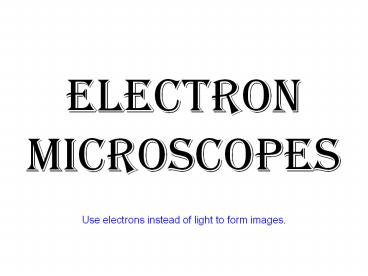Electron Microscopes - PowerPoint PPT Presentation
1 / 31
Title:
Electron Microscopes
Description:
Electron Microscopes Use electrons instead of light to form images. Light Microscopes Light Microscopes Unknown when first invented, but probably between 1590-1610 A.D. – PowerPoint PPT presentation
Number of Views:379
Avg rating:3.0/5.0
Title: Electron Microscopes
1
Electron Microscopes
Use electrons instead of light to form images.
2
Light Microscopes
3
Light Microscopes
- Unknown when first invented, but probably between
1590-1610 A.D. - Can magnify up to 1000 x
- Shines light through an object and projects the
image through a series of lenses that magnify the
image. - Relatively inexpensive
4
Uses
- Great for studying live microscopic organisms.
- Great for studying cells and tissues in general.
- Widely used in hospitals and clinics to diagnose
disease.
5
Example images using light microscopes
6
Example images using light microscopes
7
Example images using light microscopes
8
Transmission Electron Microscope(TEM)
9
Transmission Electron Microscope(TEM)
- First invented in 1931 (in Germany)
- Can magnify up to 200,000 x (and beyond)
- Similar to a light microscope except that a beam
of electrons is used instead of light. The
electrons that penetrate through the object and
create an image which is then enlarged and then
viewed on a computer monitor. - Samples of the object must be sliced very thin
before using the TEM. (No living specimens.) - Very expensive and time consuming to prepare
slides.
10
Uses of the TEM
- Used in biological/medical research to
investigate parts of cells and molecules. - Used in material science to study the structure
and the weaknesses of crystals. - Used in nanotechnology.
11
Example images using TEMs
12
Example images using TEMs
13
Example images using TEMs
Nanotubes
14
Example images using TEMs
Marburg virus
15
Scanning Electron Microscope(SEM)
- http//www.mos.org/sln/SEM/
16
Scanning Electron Microscope(SEM)
- First invented in 1942
- Can magnify typically up to 10,000 x
- Gives a 3D image of the surface of the object
- Again, a beam of electrons is used instead of
light. The electrons that bounce off the object
create the image. The microscope scans a certain
region of the object multiple times and then
combines multiple images to create what we then
see on a computer monitor as one 3D image. - No slicing needed so easier to prepare samples.
Larger objects can be viewed. - Very expensive.
17
Uses of the SEM
- Multiple uses - for viewing the surface of any
microscopic object. - Insect parts
- Bacteria
- Food industry
- Material science
- Education
- Art
18
Example images using SEMs
- Mascara brush
19
Example images using SEMs
- Moth antennae
20
Example images using SEMs
21
Practice Quiz
- Now look at the following images. Determine
which type of microscope produced each image and
write your answers down on a piece of paper. - LM Light Microscope
- TEM Transmission Electron Microscope
- SEM Scanning Electron Microscope
22
1
23
2
24
3
25
4
26
5
Mosquito
27
6
28
7
29
8
30
9
31
10































